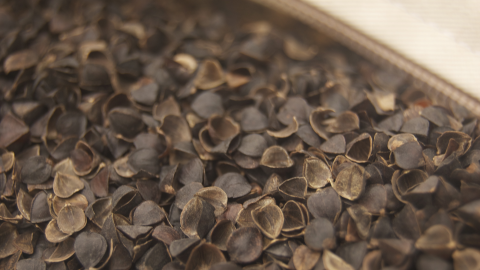
In a few years this mother will lie on her buckwheat pillow and dream of her teenage daughter’s once pleasant demeanor.
We recommend you try our own Hullo pillow, but if you are interested in how to make your own buckwheat pillow, read on…
A quality buckwheat pillow consists of the fabric case, a zipper, and of course, the magical buckwheat hull filling.
You can expect a buckwheat pillow to last several years with proper care, so think twice before you purchase any inferior materials. It can be worth a few extra dollars for superior components if it means that it’ll last a few years longer.
First you should determine what size pillow you want to make. The most popular sizes of buckwheat pillow are 14×20 and 20×26.
Buckwheat hulls are much heavier than down or foam fills — a standard sized buckwheat pillow can weigh up to 9 pounds. For that reason, you’ll need to take this extra weight into consideration when selecting your fabric. Don’t get fabric that’s too thin, or it’ll tear or wear out quickly. For a standard size pillow, use a medium weight fabric (5-7 oz. per yard), while a smaller japanese-style pillow could use something as light as 3-4 oz. per yard).
You’ll cover your pillow with a standard pillowcase, so be sure to pick an unassuming fabric that won’t clash with the pillowcase you put over it. As for the zipper, you should choose something that’s strong enough to support the full weight of the pillow in its teeth. A cheap skinny zipper that won’t stay latched under pressure will cause lots of headaches when it lets buckwheat hulls loose all over your bed.
How to Make Your Own Buckwheat Pillow
We’ve included these two YouTube links that demonstrate simple techniques for sewing the shell and zipper:
Now for the final ingredient, buckwheat hulls… A standard-sized pillow will require around 7-9 lbs of buckwheat hulls and for a japanese-style pillow about half that. Try this pillow fill calculator to help you choose the correct amount of buckwheat hulls for your pillow.
There are a lot of different varieties of buckwheat, some better than others for use in pillows. In addition, different milling processes can crush or flatten the hulls, which negates their primary benefits, malleability and breathability. It’s hard to know if you’re getting mulch-grade or premium pillow-quality without seeing them firsthand.
After a lot of detailed research, we are able to offer what we believe are the best quality pillow-grade buckwheat hulls available online. We believe you’ll find our buckwheat hulls exceptional and offer a 60 day return policy.
Fill it up and experiment with the amount of fill, it can make a big difference in how it feels. Enjoy!




